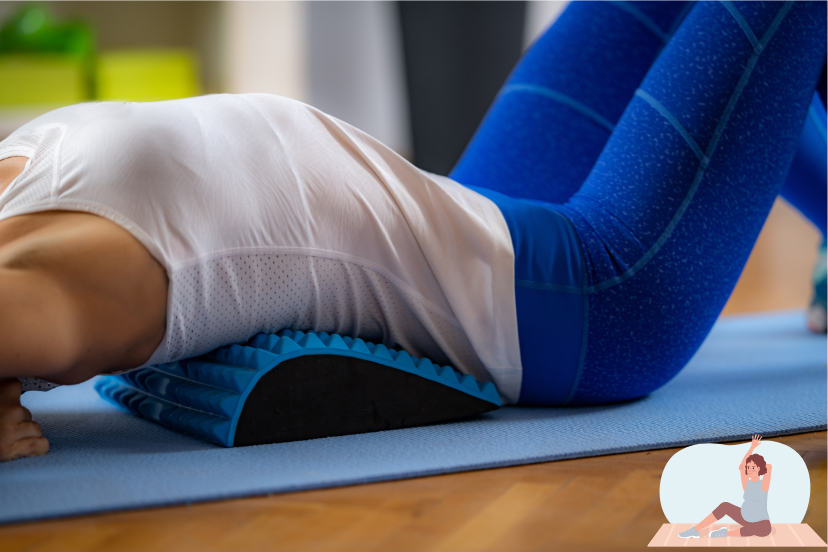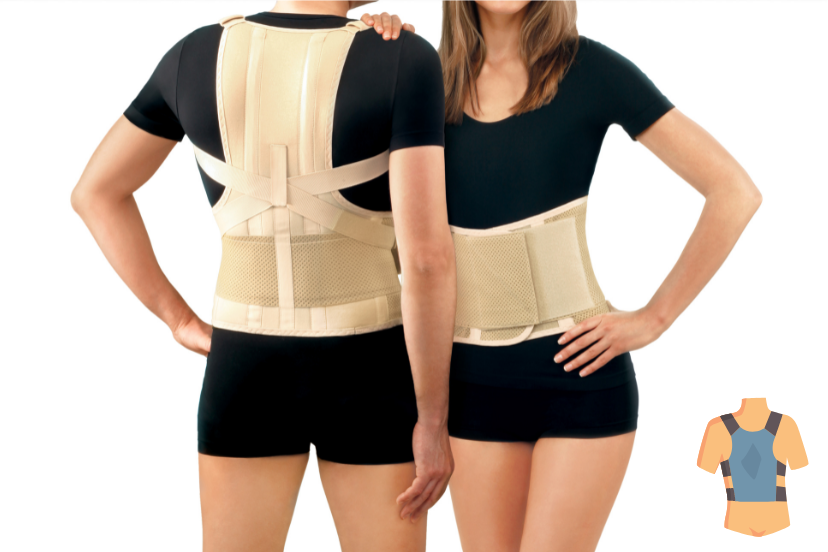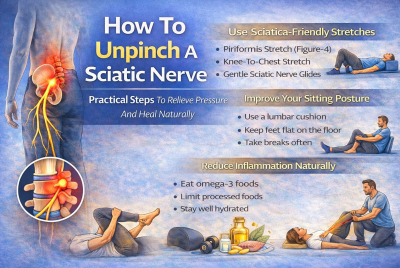Back Brace For Sciatica
Discover the benefits and considerations of using a back brace for sciatica. Explore expert recommendations for optimal relief. Dive in now! Learn how to choose the best brace, integrate it into a treatment plan, and avoid potential side effects. Get expert advice now! As someone passionate about sciatica health and eager to provide helpful suggestions, I understand the challenges and discomfort it can bring. In this article, I aim to provide helpful suggestions on using back braces to manage sciatica symptoms effectively. Sciatica can be a debilitating condition caused by compression or irritation of the sciatic nerve. It often leads to pain, numbness, and tingling sensations along the lower back, buttocks, and legs. While various treatment options are available, using a back brace for sciatica can be a valuable tool in alleviating sciatica symptoms and promoting recovery.
What Is Sciatica?
Sciatica refers to the pain that originates from the compression or irritation of the sciatic nerve. The sciatic nerve is the longest nerve in the body, running from the lower back through the buttocks and down each leg. When this nerve is irritated, it can cause radiating pain, numbness, and weakness in the affected leg. Sciatica can occur due to several factors, including herniated discs, spinal stenosis, muscle spasms, or injury.
Causes Of Sciatica
Sciatica can have various underlying causes. The most common one is a herniated disc, where the soft inner material of a spinal disc protrudes and presses on the sciatic nerve. Other causes include spinal stenosis, which is the narrowing of the spinal canal, and spondylolisthesis, a condition where one vertebra slips forward over another. Additionally, muscle spasms, spinal tumors, and injuries can also contribute to sciatica.
Symptoms Of Sciatica
The symptoms of sciatica can vary from person to person. The most common symptoms include sharp, shooting pain that radiates from the lower back to the leg, numbness or tingling sensation in the affected leg or foot, weakness in the leg muscles, and difficulty in moving or controlling the leg. In severe cases, individuals may experience bowel or bladder dysfunction, which requires immediate medical attention.
Back Braces For Sciatica
Back braces can offer short-term relief for sciatica by stabilizing the lumbar region and reducing nerve pressure. However, they are not a permanent fix. Extended use may weaken core muscles, making you dependent on the brace for support. Additionally, improper fitting or misuse can aggravate your symptoms. Consulting a healthcare provider for a precise diagnosis and individualized treatment plan is essential. Your treatment may also include physical therapy, medication, and lifestyle modifications. Use a back brace as a part of a broader treatment strategy, and always follow medical advice for optimal results.
Should You Be Wearing Back Brace For Sciatica
Is A Back Brace Good For Sciatica?
A back brace can temporarily relieve sciatica by stabilizing the spine and reducing pressure on the sciatic nerve. However, it’s not a long-term solution. Prolonged use may weaken muscles and dependency on the brace for support. Additionally, a brace could potentially exacerbate symptoms if used improperly. It’s crucial to consult a healthcare provider for an accurate diagnosis and a comprehensive treatment plan tailored to your needs. This plan may include other treatments like physical therapy, medication, and lifestyle changes, which often work more effectively in combination with the periodic use of a back brace.
The Role Of Back Braces For Sciatica
Back braces can play a significant role in managing sciatica symptoms and aiding in the recovery process. These braces provide support to the lower back, helping to alleviate pressure on the sciatic nerve. By stabilizing the spine and promoting proper posture, back braces can reduce pain and prevent further aggravation of the condition. They also offer a gentle compression that can improve blood circulation and reduce inflammation in the affected area.
Does Compression Help With Sciatica?
Compression can offer temporary relief for sciatica by reducing inflammation and providing support to the affected area. However, it’s not a long-term solution. Overusing compression techniques, like wraps or garments, may lead to other issues, such as restricted blood flow and increased dependency on support. Consulting a healthcare provider for an accurate diagnosis and comprehensive treatment plan is crucial. This plan may include medication, physical therapy, lifestyle changes, and targeted compression. Use compression as part of a broader strategy to manage sciatica symptoms, and always follow medical guidance for the most effective relief.
Types Of Back Braces For Sciatica
There are several types of back braces available for individuals with sciatica. The most common ones include lumbar braces, sacroiliac belts, and corset braces. Lumbar braces are designed to support the lower back and are often recommended for individuals with herniated discs or muscle spasms. Sacroiliac belts focus on stabilizing the sacroiliac joint, which can be a source of sciatic nerve compression. Corset braces provide full back support and are beneficial for individuals with more severe cases of sciatica or those recovering from spinal surgeries.
Benefits Of Using Back Braces For Sciatica
Using back braces for sciatica can offer several benefits. Firstly, they provide immediate pain relief by reducing pressure on the sciatic nerve and promoting proper alignment of the spine. Secondly, back braces improve stability and posture, which can prevent further injury or aggravation of the condition. Additionally, these braces can enhance mobility and allow individuals to engage in daily activities with less discomfort. They are also non-invasive and relatively affordable compared to other treatment options.
How To Choose The Right Back Braces For Sciatica
When selecting a back brace for sciatica, it is crucial to consider certain factors. Firstly, consult with a healthcare professional to determine the most suitable type of brace for your specific condition. Consider the level of support and compression required, as well as the adjustability and comfort of the brace. It is essential to choose a brace that fits properly and does not restrict movement excessively. Additionally, look for braces made from breathable materials that can be worn discreetly under clothing.
How To Wear A Back Brace For Sciatica?
To wear a back brace for sciatica, consult a healthcare provider for proper fit and usage guidelines. Begin by standing or sitting up straight to align your spine. Open the brace and wrap it around your lower back, ensuring it covers the lumbar region. Fasten the straps securely but not too tightly; you should be able to breathe comfortably. Make sure the brace offers support without causing discomfort or pinching. Follow your healthcare provider’s recommendations on how long to wear the brace each day. Periodically adjust the brace as needed, especially after physical activities, to maintain its effectiveness.
Tips For Using Back Braces For Sciatica
Follow these helpful tips to make the most out of your back brace for sciatica. Firstly, start by wearing the brace for short periods and gradually increase the duration as your body adjusts. Avoid wearing the brace for extended periods without breaks, as it is essential to allow your muscles to strengthen naturally. Additionally, incorporate gentle exercises and stretches recommended by your healthcare provider to complement the use of the brace. Maintaining good posture and avoiding activities that strain your back while wearing the brace are also crucial.
Potential Side Effects Of Back Brace For Sciatica
A back brace for sciatica can provide support, stability, and pain relief. However, there are potential side effects, although they are generally rare and often related to improper or excessive use. It’s essential to use the back brace as instructed by your healthcare professional and be aware of any potential issues. Here are some potential side effects:
Muscle Weakness
Prolonged and excessive reliance on a back brace can lead to muscle weakness or atrophy. This occurs when the muscles become overly dependent on external support and do not engage naturally. To avoid this, it is important to use the back brace as a temporary aid and gradually reduce reliance as your muscles strengthen.
Skin Irritation
Some individuals may experience skin irritation or discomfort from wearing a back brace for extended periods, particularly if the brace is ill-fitting or made from materials that are not breathable. To minimize this risk, ensure the brace fits properly, consider using padding or protective layers if necessary, and follow any instructions provided for the care and maintenance of the brace.
Dependency
Overuse or prolonged use of a back brace without appropriate breaks and exercise can potentially lead to dependency on the brace. This can hinder the natural healing process and the development of core muscle strength. It is important to use the back brace as part of a comprehensive treatment plan that includes exercise, physical therapy, and other recommended treatments.
Limited Range Of Motion
Wearing a back brace continuously and not allowing your body to move naturally can result in a limited range of motion. It’s essential to follow any recommended exercises or stretches provided by your healthcare professional to maintain flexibility and prevent stiffness.
Psychological Dependence
Some individuals may develop a psychological dependence on the back brace, feeling insecure or anxious without wearing it. It’s important to maintain a balanced approach and gradually reduce reliance on the brace as you gain strength and confidence in managing your symptoms.
It’s crucial to work closely with a healthcare professional to ensure proper usage and minimize any potential side effects. They can provide guidance on the appropriate duration and frequency of wearing the back brace based on your specific condition and progress.
If you experience any concerning symptoms or discomfort while wearing a back brace, consult with your healthcare professional for further evaluation and adjustments to your treatment plan.
Can I Wear A Back Brace All Day Long?
While wearing a back brace for extended periods may seem like a solution for continuous support, it is generally not recommended to wear a back brace all day long without breaks. Back braces are intended to provide support and stability during specific activities or periods of increased pain. Prolonged use without allowing your muscles to naturally strengthen can lead to muscle atrophy and dependency on the brace.
It is advisable to follow the guidance of a healthcare professional regarding the duration and frequency of wearing a back brace. Typically, it is recommended to start with shorter durations, gradually increasing the time as your body adjusts. Take regular breaks to allow your muscles to engage and strengthen on their own. It’s important to strike a balance between providing support and allowing your body to build its natural strength.
Alternative Treatments For Sciatica
While back braces can be beneficial, they are not the only treatment option for sciatica. Alternative treatments such as physical therapy, chiropractic care, acupuncture, and massage therapy can provide additional relief. These therapies focus on reducing muscle tension, improving flexibility, and promoting natural healing. Additionally, practicing good ergonomics, engaging in regular exercise, applying heat or cold packs, and taking over-the-counter pain medications may also help alleviate symptoms.
Exercises For Sciatica Relief

Specific exercises can help relieve sciatica pain and improve flexibility. Strengthening the core muscles, stretching the lower back and legs, and engaging in low-impact activities like swimming or walking can be beneficial. However, it is crucial to consult with a healthcare professional or a qualified physical therapist before starting any exercise regimen to ensure you are using the proper form and not exacerbating your condition.
Can I Exercise While Wearing A Back Brace For Sciatica?
Exercise can be essential in managing sciatica symptoms and promoting overall spinal health. However, whether or not you can exercise while wearing a back brace depends on the specific exercises, your condition, and the guidance of your healthcare professional.
Generally, engaging in specific exercises while wearing a back brace is possible. However, consulting with your healthcare professional or a qualified physical therapist is crucial to ensure you perform the appropriate exercises and use the proper form.
Specific low-impact exercises, such as walking, swimming, or gentle stretching, are generally considered safe to perform while wearing a back brace. These exercises can help improve flexibility, strengthen muscles, and promote overall spinal health.
However, high-impact activities, heavy lifting, or exercises that involve twisting or bending of the spine may not be suitable while wearing a back brace. These activities can potentially strain the back or interfere with the effectiveness of the brace. It is essential to follow the guidance of your healthcare professional and avoid exercises that could worsen your condition or cause additional discomfort.
Remember, exercising with sciatica primarily aims to strengthen the supporting muscles, improve flexibility, and relieve pain. A healthcare professional can guide you in selecting appropriate, safe, and beneficial exercises for your condition.
How Long Does It Take For A Back Brace To Alleviate Sciatica Pain?
The time it takes for a back brace to alleviate sciatica pain can vary depending on several factors, including the severity of your condition, individual response to treatment, and the underlying cause of your sciatica. It’s important to note that a back brace is not a standalone solution for sciatica pain relief but rather a supportive measure in conjunction with other treatments.
Wearing a back brace can provide immediate relief by reducing pressure on the sciatic nerve and promoting proper alignment of the spine. However, the effectiveness and speed of pain alleviation may vary from person to person. Some individuals may experience significant relief within a short period of wearing the brace, while others may require more time and a comprehensive approach that includes exercises, therapies, and lifestyle modifications.
Best Back Brace For Sciatica
The best back brace for sciatica varies based on individual needs, severity of symptoms, and healthcare provider recommendations. A high-quality brace should offer lumbar support, adjustable straps, and breathable material for comfort. Some people prefer rigid braces for increased stabilization, while others find flexible models more comfortable for daily activities. Always consult a healthcare provider for a fitting and integrate the brace into a comprehensive treatment plan, which may include medication, physical therapy, and lifestyle changes. Using the brace as part of a broader strategy will maximize its effectiveness and minimize potential side effects like muscle weakening.
When To Seek Medical Help
While back braces and alternative treatments can provide significant relief, knowing when to seek medical help is essential. If your sciatica symptoms worsen or persist despite conservative measures, or if you experience severe pain, loss of bladder or bowel control, or progressive weakness in the leg, it is crucial to consult a healthcare professional. They can evaluate your condition and recommend appropriate medical interventions, such as prescription medications, epidural injections, or, in rare cases, surgery.
Please note that this article should not replace professional medical advice. Consult a healthcare professional for an accurate diagnosis and tailored treatment plan.
Frequently Asked Questions (FAQs)
Does wearing a back brace help with sciatica?
A back brace may temporarily relieve sciatica by stabilizing the spine and reducing nerve pressure. However, it’s not a long-term solution. Consult a healthcare provider for individualized treatment.
Should you wear a brace for a pinched nerve?
A brace might temporarily relieve a pinched nerve by supporting and reducing movement. However, consult a healthcare provider for a proper diagnosis and individualized treatment plan.
Are back braces suitable for everyone with sciatica?
While back braces can benefit many individuals with sciatica, they may not be suitable or necessary for everyone. The use of a back brace should be based on the specific needs and recommendations of a healthcare professional who has evaluated your condition.
Back braces are commonly used for individuals with sciatica caused by herniated discs, muscle spasms, or other similar conditions. They provide support to the lower back, help alleviate pressure on the sciatic nerve, and promote proper posture. However, the effectiveness of back braces can vary depending on the underlying cause and severity of your sciatica.
How do I get my sciatic nerve to stop hurting?
Consult a healthcare professional for an accurate diagnosis and tailored treatment plan. They may recommend physical therapy, medication, or lifestyle changes to relieve sciatic nerve pain. Exercise and posture often play crucial roles.
What are the potential side effects of using a back brace for sciatica?
Potential side effects include muscle weakness, skin irritation, dependency, limited range of motion, and psychological dependence. However, they are rare and often related to improper or excessive use. Always consult a healthcare provider for personalized advice.
Extra FAQs Related To Back Brace For Sciatica
How do you calm a pinched nerve in your lower back?
Consult a healthcare professional for diagnosis and treatment options. They may suggest rest, ice or heat application, anti-inflammatory medications, and gentle stretches to alleviate pain from a pinched nerve in the lower back.
Do back braces help nerve pain?
Back braces can temporarily relieve nerve pain by stabilizing the affected area. However, they aren’t a long-term solution and may weaken muscles. Consult a healthcare provider for tailored advice.
Is it OK to wear a back brace all day?
Wearing a back brace all day may lead to muscle weakness and dependency. Consult a healthcare provider for personalized guidance on duration and proper use to avoid potential side effects.
Back Brace For Sciatica – Conclusion
In conclusion, using a back brace can be an effective tool in managing sciatica symptoms and promoting recovery. Back braces provide support, stability, and pain relief, allowing individuals to engage in daily activities with less discomfort. However, it is important to choose the right brace and use it in conjunction with other treatment options, such as exercises, alternative therapies, and lifestyle modifications. By taking a comprehensive approach, individuals with sciatica can find relief and improve their overall quality of life.
Disclaimer
Please note that this article should not replace professional medical advice. Consult a healthcare professional for an accurate diagnosis and tailored treatment plan.
👉 Explore more:
- Signs of Sciatica Improving
- KT Tape Sciatica Gluteus
- Lesser Sciatic Notch And Its Impact On Sciatica





